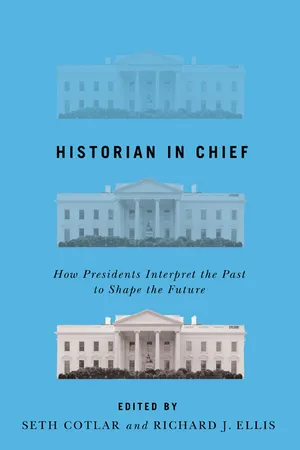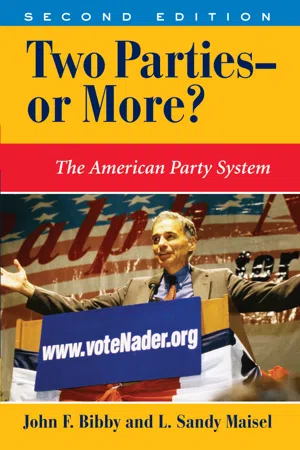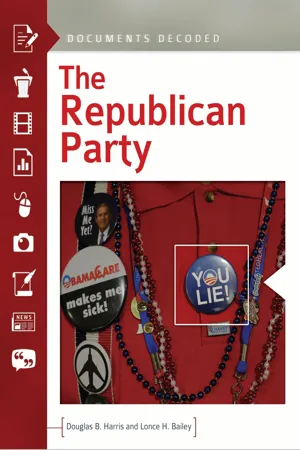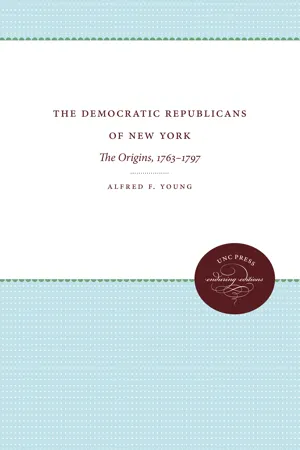History
Democratic Republican Party
The Democratic-Republican Party was an American political party formed by Thomas Jefferson and James Madison in the 1790s. It advocated for a limited federal government, states' rights, and an agrarian society. The party was a major force in American politics during the early 19th century and eventually evolved into the modern Democratic Party.
Written by Perlego with AI-assistance
Related key terms
Related key terms
1 of 4
Related key terms
1 of 3
7 Key excerpts on "Democratic Republican Party"
- eBook - ePub
Andrew Jackson and the Rise of the Democrats
A Reference Guide
- Mark R. Cheathem(Author)
- 2015(Publication Date)
- ABC-CLIO(Publisher)
CHAPTER 1
PARTY DEVELOPMENT IN THE NEW REPUBLIC
U nderstanding the evolution of the Democratic Party requires looking at the origins of the American political system. From its inception, the United States was divided about how best to preserve the liberties won by the Revolution. Two distinctly different approaches developed during the first decade of the Early Republic, creating the first American party system between the Federalists and the Jeffersonian Republicans and providing a foundation on which Jacksonian Democrats and their opponents constructed their political coalitions in the 1820s and 1830s.THE INTELLECTUAL FOUNDATION OF THE EARLY REPUBLIC
The Revolutionary and post-Revolutionary periods witnessed the United States conceiving a new political system. Prior to the Revolution, “society had been a hierarchically structured, gentry-dominated one, committed to the ideal of organic unity under the leadership of gentlemen.” By the 1770s, change was underway in colonial American society, change that the Revolution exacerbated. Throughout the rest of the 1700s, a movement began “that joined those mistrustful of power with vast numbers of traditionally powerless people in a common attempt … to challenge the eminence of a gentlemanly few.”1Colonial intellectuals and politicians adhered to a political theory, commonly referred to as classical republicanism by historians, that helped Americans of diverse interests understand the struggle that they faced. According to historian John R. Howe Jr., this worldview placed “events … in apocalyptic terms with the very survival of republican liberty riding in the balance.” Many of the European intellectuals who contributed to classical republican thought expressed their concerns about “malevolent plots and plotters.” Ironically, the Enlightenment, which emphasized rational scientific thought, encouraged conspiratorial thinking because “[i]n such a liberal and learned world there could no longer be any place for miracles or the random happenings of chance.” Just as previous generations often looked for supernatural answers to explain God’s “mysterious ways,” those American colonists influenced by the Enlightenment “sought to understand the concealed or partially exposed wills of human beings” by identifying patterns of behavior and attributing good effects to good causes and bad outcomes to bad causes. By identifying the battle between power and liberty as essential to the colonies’ future, this conspiratorial outlook shaped American colonists on both sides of the Revolution and carried over into the Early Republic’s political world. Many colonists began to believe that if they wanted equality and the freedom to pursue their own course, then they must support the fight against the ever-encroaching reach of power that threatened to corrupt their society as it had other parts of the British Empire.2 - eBook - ePub
Historian in Chief
How Presidents Interpret the Past to Shape the Future
- Seth Cotlar, Richard J. Ellis, Seth Cotlar, Richard J. Ellis(Authors)
- 2019(Publication Date)
- University of Virginia Press(Publisher)
44The central concern of Democratic Republicans and later Democrats was that the “money power” would control the central government and petition it for special privileges, and the only check on them was the people, organized and united by the political party. Though this was a process that had already been initiated a generation earlier, 1828 evinced “the raving howl of Democracy”45 in unabashed defiance of Madison’s observations in Federalist 10 that “democracies have ever been spectacles of turbulence and contention.”46 Whereas the word was once associated with civil strife and anarchy, Jackson’s supporters now dropped the “Republican” part of their party’s name and unashamedly called themselves “The Democracy” and adopted the slogan “Let the People Rule” in 1828.47 How democratic the Jacksonian era actually was remains a matter of debate, but the Democratic Party offered itself proudly and emphatically as a critique of and a solution to the Constitution’s unfinished promise to represent “We the People.”48 With this new institution, Democrats inverted the Federalists’ understanding of republicanism with the latter’s emphasis on indirect rule and complex schemes of representation, and placed their bet instead on majority rule. Instead of the formal institutions of the Constitution, Democrats placed their faith in the people directly: “where the people are everything, and political forms, establishments, institutions, as opposed to the people, nothing, there, and there only, is liberty; such a state, and such a state only, constitutes republican government.”49 Like the Anti-Federalist Melancton Smith, who believed that “representatives [should] . . . resemble those that they represent,” Van Buren and Jackson held a mirroring rather than a trusteeship theory of representation.50 “Every day,” Van Buren wrote, “convinces me more of the perfect reliance that may, under all circumstances, be placed on the intelligence, patriotism, and fortitude of the people.”51 - eBook - ePub
Two Parties--or More?
The American Party System, Second Edition
- John F Bibby(Author)
- 2019(Publication Date)
- Routledge(Publisher)
2Minor Parties in a Two-Party System: Historical Perspectives
South Carolina’s Democratic governor, J. Strom Thurmond (right) was the Dixiecrat presidential candidate in 1948. His vice presidential running mate was Governor Fielding L.Wright of Mississippi (left).T HE AMERICAN PARTY SYSTEM , which began in the 1790s, has now completed its second century. Since 1854, the same two parties—the Democratic and the Republican—have dominated electoral politics. Both have records of longevity without rival across the globe. Ironically, organized partisanship in the United States was an unplanned development. In their design for the republic, the constitutional framers did not envision a president nominated by party conventions, party-based campaigns and voting, and a Congress organized on the basis of partisanship. Early leaders such as George Washington, James Madison, and Alexander Hamilton believed that parties would be divisive and would undermine the public interest. Fearing the impending rise of political parties, Washington in his 1796 Farewell Address sounded a warning:[The spirit of party] serves always to distract the Public Councils and enfeeble the Public administration. It agitates the Community with ill-founded jealousies and false alarms, kindles the animosity of one party against another, foments occasional riot and insurrection. It opens the door to foreign influence and corruption, which find a facilitated access to government itself through the channels of party passions.Such misgivings about parties have remained a persistent feature of the American political culture. Thus, Progressive reformers in the early twentieth century imposed upon parties state-level regulations, including the requirement that they permit ordinary citizens to participate in selecting party nominees via primary elections, thereby weakening parties in a fundamental way. In the wake of the Watergate scandal of the 1970s, Congress enacted reform legislation restricting party contributions and also aiding the parties’ rivals—political action committees (PACs). - eBook - ePub
The Republican Party
Documents Decoded
- Douglas B. Harris, Lonce H. Bailey(Authors)
- 2014(Publication Date)
- ABC-CLIO(Publisher)
Indeed, the Republican presidents of the 1920s were increasingly suspicious of federal government intervention. And by the time of the Great Depression and with the election of Democratic president Franklin Roosevelt, who implemented massive new uses of the national state, Republicans were left to oppose his expansions. It was at this point that Republicans generally abandoned for good their pro-state views in favor of an ideology that posits that the central conundrum of American political life is, as Gerring puts it, “the individual versus the state.” 9 This shift is where we find the contemporary Republican Party. Although there would be lingering moderate voices in the party, the 20th century saw the Republicans shift from being proponents of the national government and state action to vehement opponents who, more like Jeffersonians in the 19th century, saw that state as a threat to individualism and liberty. In this broader picture, the small government, low tax, foreign policy adventurous Republican Party of contemporary American politics with its base in the southern states is the mirror image of the state-building nationalizing party it began as in the mid-19th century. No doubt some of these changes have been due not only to the changing nature of American politics and society but also to the strategic struggle for votes that Republicans found themselves locked in with Democrats - eBook - ePub
The Growth and Collapse of One American Nation: The Early Republic 1790 - 1861
The Early Republic 1790-1861
- Donald J Fraser, Dotti Albertine(Authors)
- 2020(Publication Date)
- Fraser & Associates(Publisher)
Beyond even these policy disputes, they differed over a vision for the future of the newly emerging nation. Because they had little experience working in a partisan environment, each party began to see the other as illegitimate. This tendency was especially strong in the Federalist Party, which held power during the Washington and Adams administrations. As historian Richard Hofstadter writes: “One of the great dangers in newly organized states is that the party in power … claims for itself the exclusive custodianship of the essence of nationality and the exclusive right to interpret the meaning of national welfare.” 2 The Federalist view of their opponents, the Republican Party of Jefferson and Madison, was that their criticism on issues was “criticism of all government,” that would ultimately lead to “anarchy, subversion, and disloyalty.” For their part, the Republicans charged the Federalists with undermining popular consent and wanting to create a monarchy in America that would lead to rule by the aristocratic few and overturn the republic. 3 The 1790s were a period when the founding generation needed to manage these extensive differences of opinion without allowing the political system to fall either into chaos or dictatorship. The outcome of these disputes was by no means assured as the decade unfolded, and the nation’s experiment with a republic almost failed before the founding generation discovered a path for organizing political differences through competition, debate, and elections, rather than violence. The two-party system would ultimately become one of the hallmarks of American nationhood. The Nature of Political Differences Before launching into the history of the 1790s, it may be instructive to take a step back and analyze the nature of political differences that have existed since the beginning of human history. Aristotle wrote that “Man is by nature a political animal.” The Greek philosopher, who lived around 300 BC, was probably onto something - eBook - ePub
Civil War America
Farming, Antislavery Politics, and Nature Parks in the Civil War Era
- Adam Wesley Dean(Author)
- 2015(Publication Date)
- The University of North Carolina Press(Publisher)
Two: Free Soil and the Rise of the Republican Party
The doctrines of Jefferson, the teachings of his example, the prestige of his name, are far more often cited and applauded in Republican than in Democratic assemblies. Nay, he and his principles are beginning to be scouted by the latter, while they are finding their home in the former.—Horace Greeley, 1860Most of the men and women involved in free-soil politics became members of the Republican Party, which was established in 1854. As the Republicans grew in popularity and power, they became convinced that the future of the country depended on the wise use of soil. Conserving the soil for multiple generations on small farms created a stable population where cities and towns could develop. Small farms, by allowing for widespread land ownership, stopped the growth of an aristocracy threatening to the Union. Slave plantations, by contrast, exhausted the soil, preventing the development of civilized communities by constantly encouraging people to seek new land. The size of plantations created an elite oligarchy—the so-called slave power—that threatened the integrity of the Union. A critique of southern land-use practices—and the larger political and economic relationships they represented—thus formed a key element of Republican ideology. These beliefs are unsurprising given that farmers were the biggest supporters of the Republicans. By contrast, most northern manufacturers viewed the Republican Party as fanatically abolitionist and were the last to abandon the Whigs. Michigan and Wisconsin, sites of the first Republican gatherings in 1854, were among the most rural states in the entire North. New England was 63.4 percent rural and the Middle Atlantic States 64.4 percent rural, while the states of the Old Northwest had a rural population of nearly 86 percent.1This chapter builds off the work of historian Mark A. Lause. In Young America: Land, Labor, and the Republican Community , Lause documents the presence of agrarian ideals in the founding of the Republican Party in 1854. Republicans, Lause proves, did not intend for their policies to create an industrial giant. They proclaimed Thomas Jefferson the ancestor of their party because of his agrarian notions of land development. Republicans also drew from the ideas of antebellum reformer George Henry Evans, who claimed that small family farms encouraged widespread land ownership and thus a more egalitarian society. Lause concludes that “agrarians favored freedom because of the real impact of slavery on the political and social health of the entire body politic as well as the inhumanity of the system.” This chapter shows that another reason agrarians opposed slavery was the impact of slavery on the physical environment. Republicans believed that only yeomen farmers could properly care for the soil.2 - eBook - ePub
- Alfred F. Young(Author)
- 2012(Publication Date)
- Omohundro Institute and UNC Press(Publisher)
Correspondence of John Jay , IV, 204-5.Passage contains an image
Chapter 26: Conclusion
By 1797 the Democratic Republicans of New York were in full bloom, the contours of the movement clearly shaped. In the political history of New York in the early national period, four broad questions emerge to which this study was directed. Who were the Democratic Republicans? What were the issues that brought the movement into being? What was it like as an organized entity? What was its philosophy?I
Who were the Republicans in New York? One of the best ways to answer this question is to ask another: who were the Federalists? In the leadership of the Federalists, the continuities in New York politics from the Revolution through the 1790’s were striking. The Federalist party of the mid-90’s was led by the same men who had led the conservative Whigs in the ‘70’s and the nationalists in the ‘80’s: Philip Schuyler, Alexander Hamilton, and John Jay above all others, James Duane, Egbert Benson, Nicholas Low, John Laurance, Stephen Van Rensselaer among the second-rank figures. These leaders were themselves of the landlord-mercantile aristocracy or were their spokesmen. There were also discontinuities. By the mid-1790’s the Federalists had lost the lower manor Livingstons completely, and could not count on the upper manor branch; Gouverneur Morris was in Europe; William Duer was in jail; Duane died in 1794. They also were joined by several new clusters of leaders whose strength lay in rural areas outside the traditional domain of the landlords and merchants: former anti-Federalists like Peter Van Gaasbeck of Ulster County and John Williams of the northern frontier, and William Cooper, Charles Williamson, and Thomas Morris of the west. In New York City and the Hudson Valley they took into their councils such former Tories as Richard Harison, Josiah Hoffman, and Samuel Jones and Yankee newcomers like Rufus King, James Watson, and Ambrose Spencer. These new leaders also tended to be men at the apex of wealth and economic power in their communities, especially on the frontier.
Index pages curate the most relevant extracts from our library of academic textbooks. They’ve been created using an in-house natural language model (NLM), each adding context and meaning to key research topics.
Explore more topic indexes
Explore more topic indexes
1 of 6
Explore more topic indexes
1 of 4






